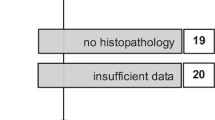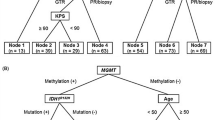Abstract
Background
Glioblastoma is a highly lethal neoplasm with a median survival of 12–14 months; only 2–5% of patients survive >3 years.
Methods
At our institute, patients with glioblastoma are initially treated with maximum tumor resection followed by radiation and the intravenous injection of nimustine hydrochloride (ACNU).
Results
Using this strategy, 18 of 123 (14.6%) patients treated at our hospital survived >3 years; 7 manifested no recurrence, and the other 11 had early recurrence and received additional therapies. To identify factors associated with prolonged survival, we compared these patients with 21 short-term (<1.5 years) glioblastoma survivors. In the long-term survivors, the MGMT promoter methylation was significantly more frequent. The rate of p53 mutation was lower, and the rate of PTEN mutations and the proliferation index were slightly higher in short-term survivors.
Conclusion
By multivariate analysis, we found that a younger age and MGMT promoter methylation were significant favorable factors in patients with glioblastoma.

Similar content being viewed by others
Abbreviations
- STS:
-
short-term survivors
- LTS:
-
long-term survivors
- ACNU:
-
nimustine hydrochloride
- MSP:
-
methylation specific PCR
- QRT-PCR:
-
quantitative real-time reverse transcription PCR
- TTP:
-
time to progression
- OS:
-
overall survival
- RS:
-
radiosurgery
- RT:
-
radiation therapy
- ICE:
-
isfosfamide + cisplatin + etoposide
- MTX:
-
methotrexate
- GAPDH:
-
glyceraldehydes-3-phosphate dehydrogenase
References
Blanc JL, Wager M, Guilhot J, Kusy S, Bataille B, Chantereau T, Lapierre F, Larsen CJ, Karayan-Tapon L (2004) Correlation of clinical features and methylation status of MGMT gene promoter in glioblastomas. J Neurooncol 68:275–283
Brell M, Tortosa A, Verger E, Gil JM, Viñolas N, Villá S, Acebes JJ, Caral L, Pujol T, Ferrer I, Ribalta T, Graus F (2005) Prognostic significance of O6-methylguanine-DNA methyltransferase determined by promoter hypermethylation and immunohistochemical expression in anaplastic gliomas. Clin Cancer Res 11:5167–5174
Burger PC, Green SB (1987) Patient age, histologic features, and length of survival in patients with glioblastoma multiforme. Cancer 59:1617–1625
Burton EC, Lamborn KR, Forsyth P, Scott J, O’Campo J, Uyehara-Lock J, Prados M, Berger M, Passe S, Uhm J, O’Neill BP, Jenkins RB, Aldape KD (2002) Aberrant p53, mdm2, and proliferation differ in glioblastomas from long-term compared with typical survivors. Clin Cancer Res 8:180–187
Chandler KL, Prados MD, Malec M, Wilson CB (1993) Long-term survival in patients with glioblastoma multiforme. Neurosurgery 32:716–720
Chen YJ, Hakin-Smith V, Teo M, Xinarianos GE, Jellinek DA, Carroll T, McDowell D, MacFarlane MR, Boet R, Baguley BC, Braithwaite AW, Reddel RR, Royds JA (2006) Association of mutant TP53 with alternative lengthening of telomeres and favorable prognosis in glioma. Cancer Res 66:6473–6476
Combs SE, Thilmann C, Edler L, Debus J, Schulz-Ertner D (2005) Efficacy of fractionated stereotactic reirradiation in recurrent gliomas: Long-term results in 172 patients treated in a single institution. J Clin Oncol 23:8863–8869
Devaux BC, O’Fallon JR, Kelly PJ (1993) Resection, biopsy, and survival in malignant glial neoplasms. A retrospective study of clinical parameters, therapy, and outcome. J Neurosurg 78:767–775
Esteller M, Hamilton SR, Burger PC, Baylin SB, Herman JG (1999) Inactivation of the DNA repair gene O6-methylguanine-DNA methyltransferase by promoter hypermethylation is a common event in primary human neoplasia. Cancer Res 59:793–797
Esteller M, Garcia-Foncillas J, Andion E, Goodman SN, Hidalgo OF, Vanaclocha V, Baylin SB, Herman JG (2000) Inactivation of the DNA-repair gene MGMT and the clinical response of gliomas to alkylating agents. N Engl J Med 343:1350–1354
Fine HA (1994) The basis for current treatment recommendations for malignant gliomas. J Neurooncol 20:111–120
Guyotat J, Signorelli F, Frappaz D, Madarassy G, Ricci AC, Bret P (2000) Is reoperation for recurrence of glioblastoma justified? Oncol Rep 7:899–904
Hegi ME, Diserens AC, Gorlia T, Hamou MF, de Tribolet N, Weller M, Kros JM, Hainfellner JA, Mason W, Mariani L, Bromberg JE, Hau P, Mirimanoff RO, Cairncross JG, Janzer RC, Stupp R (2005) MGMT gene silencing and benefit from temozolomide in glioblastoma. N Engl J Med 352:997–1003
Hsieh PC, Chandler JP, Bhangoo S, Panagiotopoulos K, Kalapurakal JA, Marymont MH, Cozzens JW, Levy RM, Salehi S (2005) Adjuvant gamma knife stereotactic radiosurgery at the time of tumor progression potentially improves survival for patients with glioblastoma multiforme. Neurosurgery 57:684–692
Kamiryo T, Tada K, Shiraishi S, Shinojima N, Kochi M, Ushio Y (2004) Correlation between promoter hypermethylation of the O6-methylguanine-deoxyribonucleic acid methyltransferase gene and prognosis in patients with high-grade astrocytic tumors treated with surgery, radiotherapy, and 1-(4-amino-2-methyl-5-pyrimidinyl) methyl-3-(2-chloroethyl)-3-nitrosourea-based chemotherapy. Neurosurgery 54:349–357
Kato H, Kato S, Kumabe T, Sonoda Y, Yoshimoto T, Kato S, Han SY, Suzuki T, Shibata H, Kanamaru R, Ishioka C (2000) Functional evaluation of p53 and PTEN gene mutations in gliomas. Clin Cancer Res 6:3743–3937
Knobbe CB, Reifenberger G (2003) Genetic alterations and aberrant expression of genes related to the phosphatidyl-inositol-3′-kinase/protein kinase B (Akt) signal transduction pathway in glioblastomas. Brain Pathol 13:507–518
Krex D, Klink B, Hartmann C, von Deimling A, Pietsch T, Simon M, Sabel M, Steinbach JP, Heese O, Reifenberger G, Weller M, Schackert G, German Glioma Network (2007) Long-term survival with glioblastoma multiforme. Brain 130:2596–2606
Martinez R, Schackert G, Yaya-Tur R, Rojas-Marcos I, Herman JG, Esteller M (2007) Frequent hypermethylation of the DNA repair gene MGMT in long-term survivors of glioblastoma multiforme. J Neurooncol 83:91–93
Morita M, Rosenblum MK, Bilsky MH, Fraser RA, Rosenfeld MR (1996) Long-term survivors of glioblastoma multiforme: clinical and molecular characteristics. J Neurooncol 27:259–266
Ohgaki H, Dessen P, Jourde B, Horstmann S, Nishikawa T, Di Patre PL, Burkhard C, Schüler D, Probst-Hensch NM, Maiorka PC, Baeza N, Pisani P, Yonekawa Y, Yasargil MG, Lütolf UM, Kleihues P (2004) Genetic pathways to glioblastoma: a population-based study. Cancer Res 64:6892–6899
Pieper RO, Patel S, Ting SA, Futscher BW, Costello JF (1996) Methylation of CpG island transcription factor binding sites is unnecessary for aberrant silencing of the human MGMT gene. J Biol Chem 271:13916–13924
Rich JN, Hans C, Jones B, Iversen ES, McLendon RE, Rasheed BK, Dobra A, Dressman HK, Bigner DD, Nevins JR, West M (2005) Gene expression profiling and genetic markers in glioblastoma survival. Cancer Res 65:4051–4058
Roth JG, Elvidge AR (1960) Glioblastoma multiforme: a clinical survey. J Neurosurg 17:736–750
Salford LG, Brun A, Nirfalk S (1988) Ten-year survival among patients with supratentorial astrocytomas grade III and IV. J Neurosurg 69:506–509
Salvati M, Cervoni L, Artico M, Caruso R, Gagliardi FM (1998) Long-term survival in patients with supratentorial glioblastoma. J Neurooncol 36:61–64
Scott JN, Rewcastle NB, Brasher PM, Fulton D, MacKinnon JA, Hamilton M, Cairncross JG, Forsyth P (1999) Which glioblastoma multiforme patient will become a long-term survivor? A population-based study. Ann Neurol 46:183–188
Shinojima N, Kochi M, Hamada J, Nakamura H, Yano S, Makino K, Tsuiki H, Tada K, Kuratsu J, Ishimaru Y, Ushio Y (2004) The influence of sex and the presence of giant cells on postoperative long-term survival in adult patients with supratentorial glioblastoma multiforme. J Neurosurg 101:219–226
Shiraishi S, Tada K, Nakamura H, Makino K, Kochi M, Saya H, Kuratsu J, Ushio Y (2002) Influence of p53 mutations on prognosis of patients with glioblastoma. Cancer 95:249–257
Smith JS, Tachibana I, Passe SM, Huntley BK, Borell TJ, Iturria N, O’Fallon JR, Schaefer PL, Scheithauer BW, James CD, Buckner JC, Jenkins RB (2001) PTEN mutation, EGFR amplification, and outcome in patients with anaplastic astrocytoma and glioblastoma multiforme. J Natl Cancer Inst 93:1246–1256
Stummer W, Pichlmeier U, Meinel T, Wiestler OD, Zanella F, Reulen HJ, ALA-Glioma Study Group (2006) Fluorescence-guided surgery with 5-aminolevulinic acid for resection of malignant glioma: a randomised controlled multicentre phase III trial. Lancet Oncol 7:392–401
Stupp R, Mason WP, van den Bent MJ, Weller M, Fisher B, Taphoorn MJ, Belanger K, Brandes AA, Marosi C, Bogdahn U, Curschmann J, Janzer RC, Ludwin SK, Gorlia T, Allgeier A, Lacombe D, Cairncross JG, Eisenhauer E, Mirimanoff RO, European Organisation for Research and Treatment of Cancer Brain Tumor and Radiotherapy Groups, National Cancer Institute of Canada Clinical Trials Group (2005) Radiotherapy plus concomitant and adjuvant temozolomide for glioblastoma. N Engl J Med 352:987–996
Tanaka S, Oka H, Fujii K, Watanabe K, Nagao K, Kakimoto A (2005) Quantitation of O6-methylguanine-DNA methyltransferase gene messenger RNA in gliomas by means of real-time RT-PCR and clinical response to nitrosoureas. Cell Mol Neurobiol 25:1067–1071
Vertosick FT Jr, Selker RG (1992) Long-term survival after the diagnosis of malignant glioma: a series of 22 patients surviving more than 4 years after diagnosis. Surg Neurol 38:359–363
Acknowledgements
This work was supported in part by Grants-in-Aid for Cancer Research from the Ministry of Health and Welfare in Japan to T.T. We thank Nippon Gene Research Laboratories Inc. for QRT-PCR and direct sequencing analysis.
Author information
Authors and Affiliations
Corresponding author
Additional information
Comment
The most reliable marker in gliomas for biological behavior has been the 1p19q abnormality described in oligodendroglial tumors. Concerning the pure astrocytic tumors, no other marker has been described that has predictive value. Early indications from a few years ago indicated that those patients who received nitrosoureas were more likely to do better if the promoter region of the MGMT gene was methylated. This study seems to corroborate this finding and indeed moves the MGMT promoter methylation status into the forefront in terms of its being predictive for outcome in patients with high-grade gliomas. More retrospective studies are obviously required to decide whether or not this is a robust marker for long- versus short-term survival. This manuscript serves as an excellent substrate on which to base those studies.
Mitchel Berger
San Francisco, CA
Rights and permissions
About this article
Cite this article
Sonoda, Y., Kumabe, T., Watanabe, M. et al. Long-term survivors of glioblastoma: clinical features and molecular analysis. Acta Neurochir 151, 1349–1358 (2009). https://doi.org/10.1007/s00701-009-0387-1
Received:
Accepted:
Published:
Issue Date:
DOI: https://doi.org/10.1007/s00701-009-0387-1




